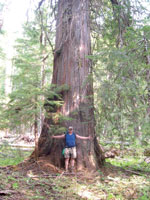
Sometimes we can't see the forest-or the trees. Yes, I know that this is a twisted cliché, but it's true in my experience.
It happened when I took my cousin Rick from Virginia on a hike near the Columbia Gorge a few years ago. I like to hike fast (I use running shoes rather than leather boots), but Rick kept slowing me down. It seemed to me that he stopped every five minutes to gaze at the trees. "Look at that!" he'd exclaim as we passed another "Doug fir" or western red cedar. The girth of these trees was stupendous, the heights astonishing. More than 220 feet above us, the tops of trees swayed in the wind.
"Oh yeah, they're big," I'd say. "Now let's move on."
But Rick couldn't withhold his wonderment-or stop taking picture after picture of the forest in the Wind River Valley. At one point, he made me pose at the base of a giant western red cedar, holding my arms out to show how wide it was.

At first it was frustrating, but he forced me to see the trees through his eyes. I had forgotten what they really looked like. I finally realized what amazing treasures they are and how lucky I was to live in this part of the world.
For many years, Northwest natives regarded our temperate conifer forests with the same jaded attitude. "A big source for lumber and a tourist attraction" was the standard point of view. But scientists from around the world-and particularly at the University of Washington-began studying these forests and their place in the world's ecosystem. Forest Resources Professor Jerry Franklin, a world authority on old growth forests, was sometimes regarded as a villain by loggers and the timber industry for research that seemed to be closing down their livelihoods.
Franklin felt it was time for a new way to study the canopies of our temperate forests in the Pacific Northwest. So the UW, in partnership with the U.S. Forest Service, got the funding and found a site for the world's largest forest research crane -a 25-story monster in the Wind River Valley near Stevenson and the Columbia River Gorge. It was the same forest where Rick and I hiked.
After five years of high-level research, it was time to send University Photographer Mary Levin to capture the work scientists are doing. Mary came back with spectacular photos, but we discovered more about our forest than its beauty. It turns out, thanks to Wind River Experimental Forest research, that a temperate conifer forest soaks up tons of carbon found in the atmosphere. Most scientists feel that our planet is suffering from global warming due to excess carbon dioxide in the atmosphere. These gases trap solar radiation, causing a greenhouse effect.
There are many steps the citizens of Planet Earth must take to stem global warming-and one of them is to find a place to deposit excess carbon produced by the burning of coal, oil and natural gas. UW scientists think that our temperate conifer forests may be one of the most efficient ways to "bank" carbon on the planet.
This finding may never have happened if UW researchers like Franklin hadn't decided to take a second look at our forests. It pays off to stop and take new perspective-whether it is through the eyes of a cousin from Virginia or from the top of a 275-foot crane.